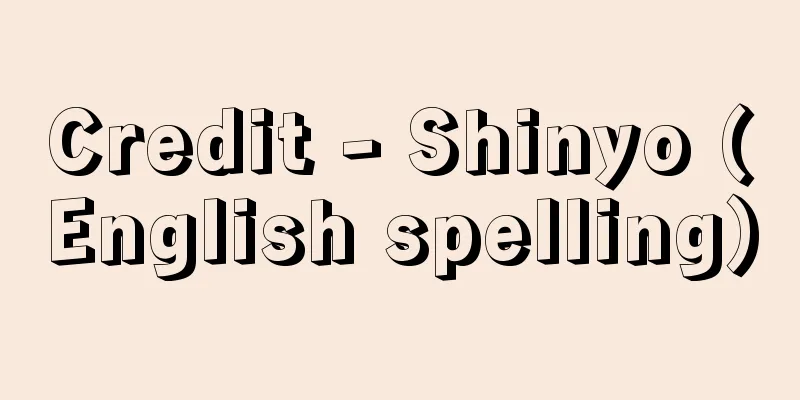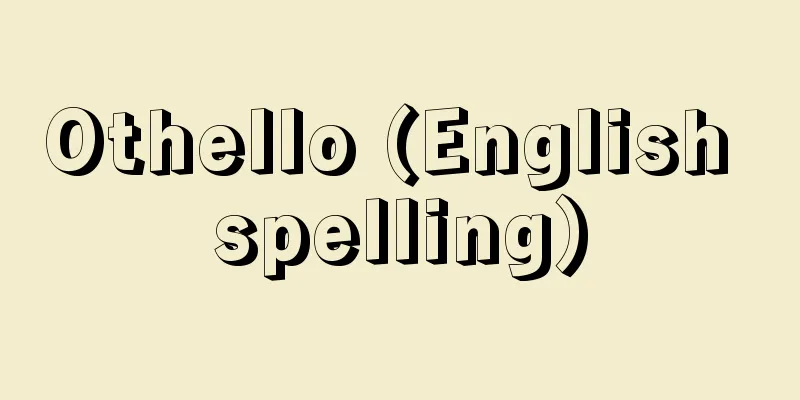Credit - Shinyo (English spelling)

|
Generally speaking, it means trust or confidence, but in economics, when we talk about giving credit (credit, granting) or receiving credit (receiving), or when we talk about lending credit or creating credit, we are referring to the relationship of credit and debt. [Yoshinori Suzuki] Credit and monetary creditThere are two aspects to credit. The first is credit as a transaction, i.e., the meaning of the transactional relationship itself, such as when A lends money to B, that is, borrowing and lending credit. The second is the credit-debt relationship that arises as an objective reality as a result of such a transaction, which can be used as a means or object of the transaction. This is monetary credit. The modern credit system and credit currency system are nothing but the socialization and systematization of these two aspects of credit. The institutional system of the deposit banks surrounding the central issuing bank is a social system of lending and borrowing credit. And since the credit currency system, such as banknotes and deposit currency, is built into it, it is also nothing but a social system of credit currency. [Yoshinori Suzuki] Commercial and bank creditThe main types of lending credit are commercial credit and bank credit. Commercial credit is a credit relationship that arises from credit sales and purchases between producers and merchants who give each other goods. Thus, the seller has a credit and the buyer has a debt. This saves on purchase and payment reserves during the distribution period, shortens the distribution period, and enables continuous production. In other words, it makes it possible to expand the reproduction process. Bank credit is a type of lending transaction conducted by financial institutions such as banks. Commercial credit has its own individual capital constraints, and to overcome these, bank credit, which is a more social credit, was introduced. In other words, bank credit is nothing other than credit provided by banks that are independent outside the reproduction process. A typical example of the subrogation of commercial credit by bank credit is bill discounting. Bill discounting is when a bank acquires commercial bills held by a discounter on behalf of the discounter, lends banknotes representing the bank's own debt, and circulates them on a subrogation basis. This releases the discounter from the burden of reserve capital and allows them to continue reproduction without being bound by the actual return of capital. [Yoshinori Suzuki] Commercial and bank currencyMonetary credit takes the form of credit money. Credit money can be commercial money or bank money. Commercial money is when bills, which are certificates arising from commercial credit relationships, are used as a means of circulation. In other words, commercial bills are endorsed and transferred and circulate from one place to another along the chain of commercial credit. The final payer simply pays on the due date, and no cash is exchanged between the intermediate parties. Bills can circulate because the credits and debts held by each person in the chain of credit are offset, and bills function absolutely as money through the offsetting of credits and debts. This saves circulating capital (purchase and payment reserves) on the one hand, and original currency (gold) on the other. Bank currency includes banknotes and deposit coins. Banknotes were originally convertible banknotes, which were the monetization of the issuing bank's gold payment obligations. In the early days, banknotes bore interest and were in large denominations with decimals, but gradually they became smaller denominations payable at sight and were converted into cash. Although their essence is a promissory note issued by the bank to itself, and buying and selling them undoubtedly creates a chain of credit-debt relationships with the bank as a party, banknotes are treated as cash and leave commercial circulation and enter general circulation. Deposit money is the monetization of deposit payment liabilities (or, conversely, the right to claim repayment). Payment liabilities arising from the deposit transaction of a deposit are transferred between customers. In terms of the transfer of a bank's own liabilities into circulation, there is no difference between banknotes and deposit money. However, while banknotes are supported by the payment capacity of the issuing bank, deposit money is limited by the payment capacity of the individual capitalists who are its customers. [Yoshinori Suzuki] "Basic Theory of Money and Finance" by Takagi Nobuya and Takemura Shuichi (1968, Minerva Shobo) " ▽ "Financial Economics" edited by Takemura Shuichi and Tamanoi Masao (1978, Yuhikaku)" ▽ "The Economics of the Credit System" by Shimohirao Isao (1999, Shinhyoron)" ▽ "The Economics of Credit and Trust: How to Change the Financial System" by Takeda Shigeo (2001, NHK Books)" ▽ "New Monetary Theory: The Economics of Trust and Information" by Joseph E. Stiglitz and Bruce Greenwald, translated by Naito Junichi and Iemori Nobuyoshi (2003, University of Tokyo Press)" [Reference items] | | | |Source: Shogakukan Encyclopedia Nipponica About Encyclopedia Nipponica Information | Legend |
|
一般的には信頼または信任を意味するが、経済上、信用を与える(与信、授信)とか信用を受ける(受信)、また信用を貸し付けるとか信用を創造するとかいわれる場合の信用とは、債権・債務関係のことを意味している。 [鈴木芳徳] 貸借的信用と貨幣的信用信用には二つの側面がある。第一は、取引としての信用であって、たとえば甲が乙に貸し付けるというような取引関係そのものの意味、すなわち貸借的信用である。第二に、そういう取引行為の結果生じる客観的実在としての債権・債務関係が、取引にとっての手段ないし対象とされることがある。これが貨幣的信用である。 近代的な信用制度と信用通貨体制とは、信用のこうした2側面が社会化され、体系化されたものにほかならない。中央発券銀行を頂点とし、それを取り巻く預金銀行の制度体系は貸借的信用の社会的体系である。そしてその内部に、銀行券、預金通貨といった信用貨幣の体系が組み込まれているのであるから、それはまた信用通貨の社会的体系にほかならない。 [鈴木芳徳] 商業信用と銀行信用貸借的信用のおもなものは商業信用と銀行信用である。商業信用とは、生産者や商人が商品でもって相互に与え合う掛売り・掛買いから生まれる信用関係である。したがって売り手は債権を、買い手は債務を負う。このことにより、流通期間中の購買・支払準備金が節約され、流通期間が短縮されて連続的な生産が可能となる。つまり再生産過程の拡大が可能となる。 銀行信用とは、銀行などの金融機関が行う貸付取引のことである。商業信用には固有の個別資本的制約があり、それを克服するためのものとして、より社会的な信用である銀行信用が導入される。すなわち、銀行信用とは、再生産過程の外部に自立化した銀行によって与えられる信用にほかならない。 銀行信用による商業信用の代位形態のうち、代表的なものが手形割引である。手形割引とは、割引依頼人のもつ商業手形を銀行が肩代り入手し、銀行の自己宛(あて)債務を表示する銀行券を貸し付けて、これを代位流通させることである。これにより割引依頼人は予備資本の負担から解放され、資本の現実的還流に拘束されることなく再生産を続行することができる。 [鈴木芳徳] 商業貨幣と銀行貨幣貨幣的信用は信用貨幣の形態をとる。信用貨幣には商業貨幣と銀行貨幣がある。商業貨幣とは、商業信用関係から生じる証書である手形が流通手段として用いられるものをいう。すなわち、商業信用の連鎖にのって、商業手形は裏書譲渡されて転々流通する。最終支払人が支払期日に支払うのみで、中間当事者にあってはまったく現金の授受は生じない。手形が流通しえた理由は、信用の連鎖において各人がもつ債権・債務が相殺されるからであって、手形は債権・債務の相殺により絶対的に貨幣として機能するのである。このことにより、一方では流通資本(購買・支払準備金)が節約され、他方では本来の貨幣(金)が節約される。 銀行貨幣には銀行券と預金貨幣がある。銀行券は元来、兌換(だかん)銀行券であり、それは発券銀行の金支払債務の貨幣化したものである。銀行券はその初期においては利子付きで大額であり、金額にも端数があったが、しだいに一覧払いで小額のものになることで現金化した。その本質が銀行の自己宛約束証書であり、これによる売買が銀行を当事者とする債権・債務関係の連鎖形成であるに違いないとはいえ、銀行券は現金としての扱いを受け、商業流通を出て一般的流通に入るのである。 預金貨幣は、預金支払債務(逆にみると払戻請求権)の貨幣化したものである。預金という寄託取引のうえに生じた支払債務が顧客の間で移転される。銀行の自己宛債務の流通移転という意味では、銀行券と預金貨幣とはなんら異なるところはない。ただ、銀行券の場合には発券銀行の支払能力によって支えられているのに対し、預金貨幣は顧客たる個別資本家の支払能力によって限界づけられている。 [鈴木芳徳] 『高木暢哉・竹村脩一著『貨幣・金融の基礎理論』(1968・ミネルヴァ書房)』▽『竹村脩一・玉野井昌夫編『金融経済論』(1978・有斐閣)』▽『下平尾勲著『信用制度の経済学』(1999・新評論)』▽『竹田茂夫著『信用と信頼の経済学――金融システムをどう変えるか』(2001・NHKブックス)』▽『ジョゼフ・E・スティグリッツ、ブルース・グリーンワルド著、内藤純一・家森信善訳『新しい金融論――信用と情報の経済学』(2003・東京大学出版会)』 [参照項目] | | | |出典 小学館 日本大百科全書(ニッポニカ)日本大百科全書(ニッポニカ)について 情報 | 凡例 |
>>: Shinyu Kyogoku - Shinyu Kyogoku
Recommend
Lyrodus pedicellatus (English spelling) Lyroduspedicellatus
... Twenty species of Teredinidae have been recor...
Legacy - Yuiryo
〘 noun 〙 The territory that is left after someone&...
Apert, GV - Apert
...The first class of 50 students enrolled in the...
Kongorinji Temple
A Tendai sect temple located in Matsuoji, Aisho-c...
Unit - Tan'i (English spelling) unit English
A fixed quantity that serves as a standard for me...
Oates - Joyce Carol Oates
An American female writer. Born in Lockport, New ...
Aristotle's Philosophy
…Many of his philosophical works were translated ...
Tantrum - Tantrum
〘Noun〙① (It is said because anger was thought to b...
Cicadelloidea
…A general term for insects of the superfamily Ci...
Nupharidine
...The seeds and rhizomes contain a lot of starch...
Time series - jikeiretsu (English spelling) time series
A time series is a sequence of values that are o...
Queen Anne's Gift
…In Scotland, which had been in a personal union ...
Mount Imakira - Imakira Dake
…It belongs to Toshima Village, Kagoshima County....
Siegfried (English spelling)
...The first night, Die Walküre (3 acts, 1856), t...
Ikeno
One of the surnames. Source: The Selected Edition ...









